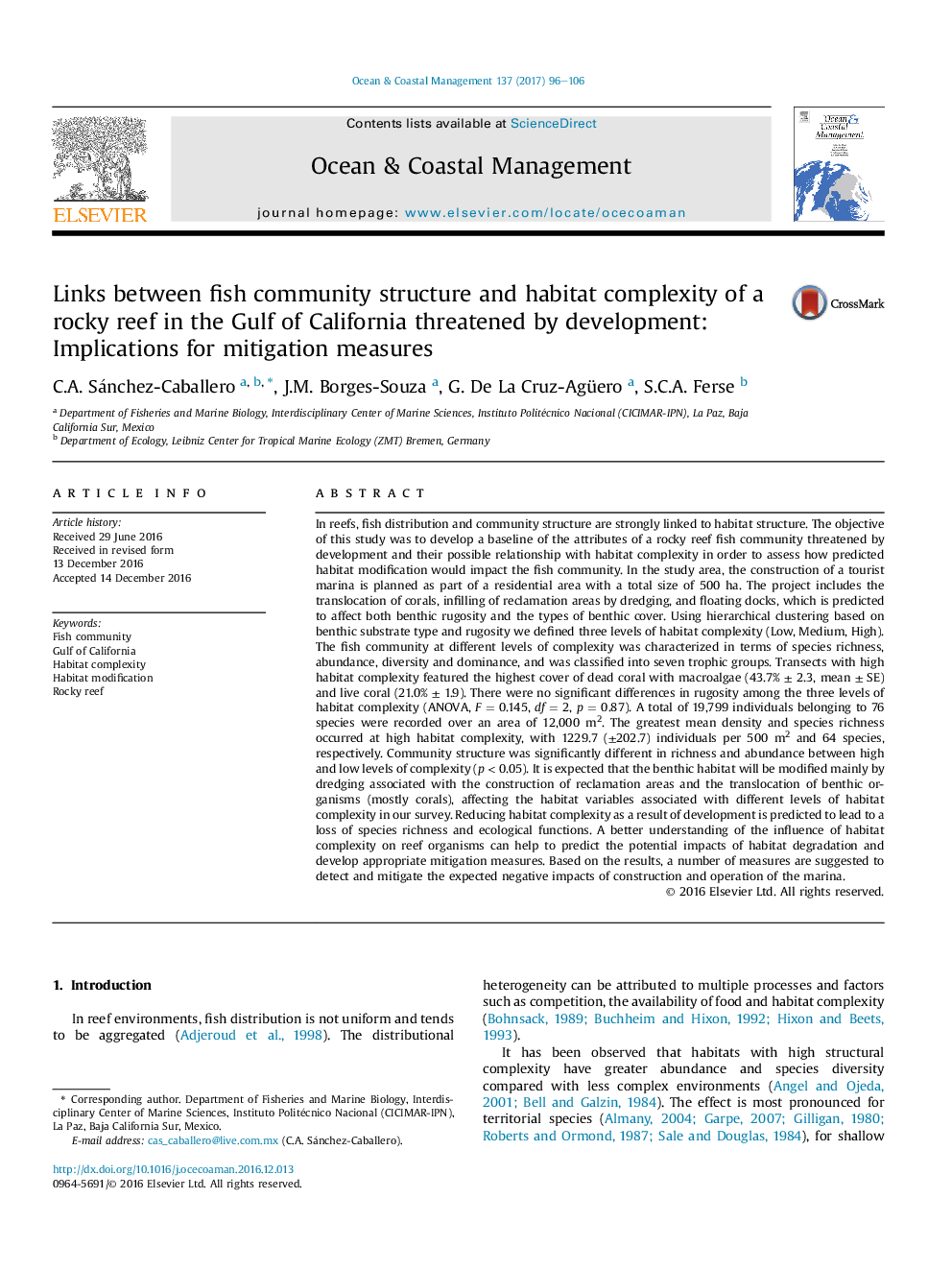| کد مقاله | کد نشریه | سال انتشار | مقاله انگلیسی | نسخه تمام متن |
|---|---|---|---|---|
| 5473998 | 1520492 | 2017 | 11 صفحه PDF | دانلود رایگان |
عنوان انگلیسی مقاله ISI
Links between fish community structure and habitat complexity of a rocky reef in the Gulf of California threatened by development: Implications for mitigation measures
ترجمه فارسی عنوان
ارتباط بین ساختار جامعه ماهی و پیچیدگی زیستگاه یک صخره سنگی در خلیج کالیفرنیا تحت تهدید توسعه است: پیامدهای اقدامات کاهش
دانلود مقاله + سفارش ترجمه
دانلود مقاله ISI انگلیسی
رایگان برای ایرانیان
کلمات کلیدی
جامعه ماهی، خلیج کالیفرنیا، پیچیدگی محل زندگی، تغییر محل زندگی، صخره های صخره ای،
موضوعات مرتبط
مهندسی و علوم پایه
علوم زمین و سیارات
اقیانوس شناسی
چکیده انگلیسی
In reefs, fish distribution and community structure are strongly linked to habitat structure. The objective of this study was to develop a baseline of the attributes of a rocky reef fish community threatened by development and their possible relationship with habitat complexity in order to assess how predicted habitat modification would impact the fish community. In the study area, the construction of a tourist marina is planned as part of a residential area with a total size of 500 ha. The project includes the translocation of corals, infilling of reclamation areas by dredging, and floating docks, which is predicted to affect both benthic rugosity and the types of benthic cover. Using hierarchical clustering based on benthic substrate type and rugosity we defined three levels of habitat complexity (Low, Medium, High). The fish community at different levels of complexity was characterized in terms of species richness, abundance, diversity and dominance, and was classified into seven trophic groups. Transects with high habitat complexity featured the highest cover of dead coral with macroalgae (43.7% ± 2.3, mean ± SE) and live coral (21.0% ± 1.9). There were no significant differences in rugosity among the three levels of habitat complexity (ANOVA, F = 0.145, df = 2, p = 0.87). A total of 19,799 individuals belonging to 76 species were recorded over an area of 12,000 m2. The greatest mean density and species richness occurred at high habitat complexity, with 1229.7 (±202.7) individuals per 500 m2 and 64 species, respectively. Community structure was significantly different in richness and abundance between high and low levels of complexity (p < 0.05). It is expected that the benthic habitat will be modified mainly by dredging associated with the construction of reclamation areas and the translocation of benthic organisms (mostly corals), affecting the habitat variables associated with different levels of habitat complexity in our survey. Reducing habitat complexity as a result of development is predicted to lead to a loss of species richness and ecological functions. A better understanding of the influence of habitat complexity on reef organisms can help to predict the potential impacts of habitat degradation and develop appropriate mitigation measures. Based on the results, a number of measures are suggested to detect and mitigate the expected negative impacts of construction and operation of the marina.
ناشر
Database: Elsevier - ScienceDirect (ساینس دایرکت)
Journal: Ocean & Coastal Management - Volume 137, 1 March 2017, Pages 96-106
Journal: Ocean & Coastal Management - Volume 137, 1 March 2017, Pages 96-106
نویسندگان
C.A. Sánchez-Caballero, J.M. Borges-Souza, G. De La Cruz-Agüero, S.C.A. Ferse,
